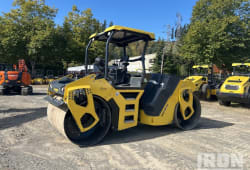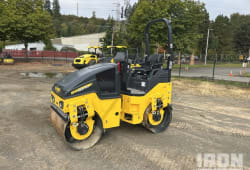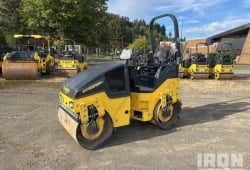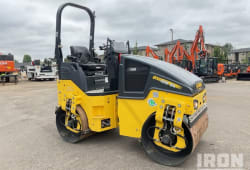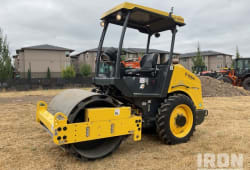The Vibratory Compactors: Your Heavy Equipment Inspection Guide
10 Min read
)
November 17, 2023
Mario Ramirez, an expert heavy equipment inspector at Boom & Bucket, shares his deep expertise in heavy equipment inspection so you can make better buying decisions.
Vibratory compactors are essential heavy equipment used in construction projects. Their primary function is to compact soil, gravel, and other materials to create a stable and solid surface. To ensure their optimal performance and longevity, regular inspection and maintenance are crucial. In this comprehensive guide, we will delve into the world of vibratory compactors, understanding their role in construction, exploring key components, and learning how to conduct a thorough inspection. Additionally, we will discuss the importance of addressing any identified issues and establishing a routine maintenance plan to keep your vibratory compactors in excellent working condition.
Understanding Vibratory Compactors
The Role of Vibratory Compactors in Construction
Vibratory compactors play a vital role in construction projects by compacting various materials to create a solid foundation. Whether it is a road, parking lot, or building site, these machines ensure the stability and durability of the structure. Vibratory compactors use vibration and weight to compress the soil particles, reducing air gaps and increasing the soil's density. This process enhances load-bearing capacity and minimizes settlement, preventing future damage.
When it comes to constructing a road, for example, a vibratory compactor is used to compact the soil or aggregate layers. The machine's vibrating action helps to rearrange the particles, making them more closely packed together. This results in a stronger and more stable road surface that can withstand heavy traffic and adverse weather conditions.
In parking lot construction, vibratory compactors are used to ensure a level and sturdy surface. By compacting the soil or aggregate layers, these machines create a solid foundation that can support the weight of vehicles without sinking or shifting. This prevents the formation of potholes and uneven surfaces, providing a smooth and safe parking area for cars.
Similarly, in building site preparation, vibratory compactors are used to compact the soil before laying the foundation. This ensures that the ground is stable and can support the weight of the building. By reducing air gaps and increasing the soil's density, these machines prevent settlement and potential structural damage in the future.
Key Components of Vibratory Compactors
:format(webp))
To comprehend the inspection process, it is essential to familiarize yourself with the key components of vibratory compactors. These components include the engine, vibratory mechanism, hydraulic system, drums or plates, and operator controls. Each component plays a vital role in the machine's performance and efficient operation. Understanding their function will aid in identifying potential issues during your inspection.
The engine is the heart of the vibratory compactor, providing the power needed to operate the machine. It drives the vibratory mechanism and hydraulic system, ensuring smooth and efficient compaction. Regular maintenance and proper lubrication of the engine are crucial to keep the compactor running smoothly.
The vibratory mechanism is responsible for generating the vibrations that compact the soil. It consists of an eccentric weight that rotates at high speeds, creating the necessary vibrations. The design and quality of the vibratory mechanism greatly influence the compactor's performance and compaction efficiency.
The hydraulic system controls the movement of the drums or plates, allowing for precise compaction. It also provides the necessary force to drive the machine forward. Proper maintenance of the hydraulic system, including regular inspection of hoses and seals, is important to prevent leaks and ensure optimal performance.
The drums or plates are the actual compaction elements of the machine. They come in different shapes and sizes, depending on the specific application. The design of the drums or plates determines the type of material that can be effectively compacted. Regular inspection of the drums or plates is essential to identify any signs of wear or damage that may affect the compaction process.
Lastly, the operator controls allow the operator to maneuver the machine and adjust its settings. These controls include steering, speed control, and vibration intensity. Proper training and familiarity with the operator controls are necessary to operate the vibratory compactor safely and efficiently.
By understanding the key components of vibratory compactors, you can effectively inspect and maintain these machines, ensuring their optimal performance and longevity. Regular inspection, maintenance, and adherence to safety protocols are essential to keep vibratory compactors in top condition, enabling them to fulfill their crucial role in construction projects.
The Importance of Regular Inspection
Regular inspection is a critical aspect of working with heavy equipment like vibratory compactors. It not only ensures the safety of operators and other workers on-site but also helps maintain the efficiency and performance of the machines. By thoroughly inspecting the equipment before starting any job, you can identify and address safety concerns, such as loose bolts, worn-out tires, malfunctioning brakes, or leaky hydraulic hoses. Taking the time to address these issues will mitigate the risk of accidents and ensure the well-being of everyone involved.
Safety Concerns with Vibratory Compactors
When it comes to vibratory compactors, safety should always be a top priority. These powerful machines are designed to compact soil, asphalt, and other materials, making them essential in construction and roadwork projects. However, their size and force can also pose potential hazards if not properly maintained and inspected.
Loose bolts, for example, can compromise the stability and structural integrity of the compactor. Vibrations from the machine's operation can cause these bolts to gradually loosen over time, increasing the risk of parts coming loose or even detachment during use. Regular inspection allows operators to identify any loose bolts and tighten them before they become a safety concern.
Worn-out tires are another safety concern that can be identified through inspection. The tires of a vibratory compactor are crucial for providing traction and stability during operation. If the tires are worn down or damaged, it can affect the machine's maneuverability and increase the risk of accidents, especially on uneven or slippery surfaces. By inspecting the tires regularly, operators can identify any signs of wear and tear and replace them promptly to maintain optimal safety.
Malfunctioning brakes are yet another safety concern that can be addressed through inspection. Vibratory compactors often operate on slopes or inclines, making it essential for them to have reliable braking systems. If the brakes are not functioning correctly, it can lead to accidents, especially when trying to stop or slow down the machine. Regular inspection allows operators to check the brakes' condition and ensure they are in proper working order before starting any job.
Leaky hydraulic hoses are also a safety concern that can be identified through inspection. Vibratory compactors rely on hydraulic systems to generate the force needed for compaction. If there are leaks in the hydraulic hoses, it can affect the machine's performance and potentially lead to hydraulic failure during operation. Regular inspection allows operators to detect any leaks and address them promptly, preventing any potential accidents or damage to the machine.
Maintaining Efficiency and Performance
In addition to safety concerns, regular inspection plays a crucial role in maintaining the efficiency and performance of vibratory compactors. These machines are designed to deliver high compaction forces, ensuring the stability and durability of construction projects. However, like any mechanical equipment, they are subject to wear and tear over time.
By periodically assessing the condition of the machine, operators can identify minor problems or signs of wear and tear that could potentially lead to more significant issues if left unattended. For example, they may notice unusual vibrations, strange noises, or decreased compaction efficiency. Addressing these concerns promptly through regular inspection and maintenance will optimize the equipment's performance, prevent costly breakdowns, and extend its lifespan.
Regular inspection also allows operators to identify and address any potential issues that may affect the compactor's performance. For example, they may notice a decrease in fuel efficiency, which could be due to a clogged air filter or a malfunctioning engine component. By inspecting these areas regularly, operators can identify and resolve such issues, ensuring that the compactor operates at its optimal level and minimizes fuel consumption.
In conclusion, regular inspection is of utmost importance when working with vibratory compactors. It not only ensures the safety of operators and other workers on-site but also helps maintain the efficiency and performance of the machines. By identifying and addressing safety concerns and potential issues through inspection, operators can mitigate the risk of accidents, prevent costly breakdowns, and optimize the compactor's lifespan. So, always make it a priority to thoroughly inspect the equipment before starting any job.
Pre-Inspection Preparation
Gathering the Necessary Tools
Before starting the inspection, gather the necessary tools and equipment. These may include a flashlight, gloves, safety glasses, a pry bar, a torque wrench, and a pressure gauge. Having these tools readily available will streamline the inspection process and ensure accurate assessment of the various components.
Safety Measures Before Inspection
Prioritize safety before beginning the inspection. Make sure the vibratory compactor is turned off and parked on a level surface. Engage the parking brake, and if possible, chock the wheels to prevent any accidental movement. Review the operator's manual for any additional safety measures specific to your machine. Always wear appropriate personal protective equipment (PPE) while conducting inspections.
Step-by-Step Inspection Guide
Checking the Exterior Components
The first step in the inspection process is to examine the exterior components of the vibratory compactor. Inspect the frame for any signs of damage or cracks. Check for loose or missing fasteners, such as bolts or nuts. Examine the tires or tracks for wear and ensure they are properly inflated. Inspect the lights, mirrors, and other safety features to confirm they are functional and undamaged.
Inspecting the Vibratory Mechanism
Move on to inspecting the vibratory mechanism. Check the exciter shafts, bearings, and seals for any signs of wear or leakage. Inspect the eccentric weights and ensure they are securely attached. Assess the condition of the vibration isolation mounts and replace any that appear cracked or worn. Verify that the vibration settings and controls are working correctly.
Evaluating the Hydraulic System
An essential part of the inspection is evaluating the hydraulic system. Check for any hydraulic fluid leaks, paying close attention to hoses, connectors, and cylinders. Inspect the hydraulic filters and replace them if necessary. Verify that all hydraulic components are functioning properly by operating the controls through their full range. Monitor the hydraulic pressure to ensure it falls within the manufacturer's recommended range.
Post-Inspection Actions
Addressing Identified Issues
If any issues or abnormalities were identified during the inspection, take prompt action to address them. Make a note of the problems and prioritize them based on their severity. Simple repairs or adjustments can typically be performed on-site, while more significant issues may require the assistance of a qualified technician. Remember to document all maintenance and repairs for future reference.
Regular Maintenance for Longevity
Inspection is just one part of maintaining vibratory compactors. Establishing a routine maintenance plan is crucial for their longevity. Follow the manufacturer's recommended maintenance schedule, which may include regular oil changes, filter replacements, greasing, and inspection of specific components. Properly maintaining your vibratory compactors will minimize downtime, reduce repair costs, and extend their service life.
By following this comprehensive guide, you can become proficient in inspecting vibratory compactors. Regular inspection and maintenance will not only ensure the safe operation of these machines but also optimize their performance and longevity. Remember, every inspection serves as an opportunity to identify and address potential issues, mitigating the risk of costly breakdowns and ensuring the smooth progress of your construction projects.
